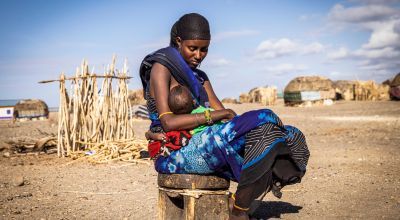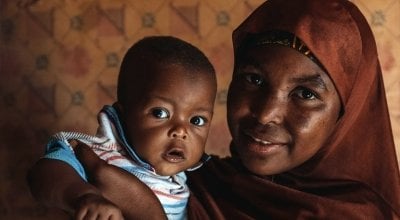
Read our 2024 annual report

Knowledge Hub
Stunting, or significantly impaired growth and development, affects almost 22% of children around the world.
Here’s a look at the condition and its impact across generations.
What is stunting?
Stunting is when a child has a low height for their age. This is usually due to malnutrition, repeated infections, and/or poor social stimulation. The World Health Organisation categorises children who are stunted as those whose height is lower than average for their age, and at least two standard deviations below the WHO’s Child Growth Standards Median. Stunting is different from wasting. If stunting is a low height for a child’s weight, wasting is low weight for a child’s height.
The real-world impacts of stunting ripple well beyond physical growth. A stunted child may also have a poorer immune system, brain function, and organ development. Performing below-average in these areas may also limit their future productivity and threaten the health of their own children.
But there are measures we can take to prevent stunting, especially in the first 1,000 days between pregnancy and a child’s second birthday. For stunted children, some effects can be reduced and even reversed.
What causes stunting?
There are many factors that contribute to childhood stunting, and these factors are often linked. Some common factors linked to stunting include:
- Poor nutrition and a lack of access to diverse foods
- Poor sanitation and no access to clean drinking water
- Lack of proper healthcare for children and their mothers
- Inadequate psychosocial stimulation and/or parent-infant bonding
None of these causes exist in a vacuum. Gender equality, male engagement in parenting, and conflict can all contribute to a child’s psychosocial stimulation. Conflict, along with income opportunities, food prices, and the climate crisis, may affect food availability and in turn contribute to undernutrition or malnutrition.
Finally, stunting is often intergenerational: Children who are stunted are more likely as adults to have stunted children. A stunted child is also more prone to becoming overweight as an adult, posing additional health risks.
The vicious cycle of stunting
After a child is born, it’s important for both mother and baby receive proper postnatal care. For babies born into poverty, one of the most important weapons to combat stunting is breast milk, which strengthens their immune system and provides the nutrients children need to grow.
If a mother is malnourished, it’s more likely that her baby will be born underweight. This sets off a cycle of stunting: Without proper postnatal care and the proper nutrients, the baby will likely suffer from stunted growth. If the child’s malnutrition goes untreated, they themselves may grow into a young woman who becomes a malnourished mother to a stunted child.
Beyond the transgenerational cycle of stunting, there are a number of other factors at play: Children who suffer from stunting may never reach their full cognitive potential, which can lead to a lower IQ and impaired brain development. This also affects socio-emotional skills and overall health. All of these factors ultimately relate to long-term potential, including economic and health possibilities.
A 2011 study conducted by Sue Horton and Richard Steckel for the Copenhagen Consensus on Human Challenges suggests that well-nourished children are 33% more likely to escape poverty as adults. But how do they break the cycle?
How do we prevent stunting?
There’s no simple solution to prevent stunting.
However, focusing on what is commonly referred to as the first 1,000 days — the window of time between a mother’s pregnancy and her child’s second birthday — is a key opportunity to ensure the healthy development of children around the world.
While the amount of food is a large piece of the puzzle, a diversified diet can be equally, if not more, important. Treating malnutrition, even in those children who are older than two, with ready-to-use therapeutic food (RUTF) can have a positive impact on stunting rates.

How we can help
Concern Worldwide work with local communities to address the various causes of stunting. Through improved agricultural techniques — like Climate Smart Agriculture — we help families increase and diversify food production.
To ensure these crucial initiatives can move forward without our long-term support, Concern often partners with local governments to improve health, nutrition, agriculture, and hygiene services, and to promote gender parity. We also work within communities so that their members have ownership over these programmes.
Here’s five sustainable solutions to help prevent stunting:
Promote gender equality
Improving gender equality is an essential objective, so we work to engage men as allies. In most of the countries where we work, we are building or improving water and sanitation facilities and training communities on good health and hygiene habits.
Improve agriculture
With the help of the International Food Policy Research Institute, Irish Aid, and the Kerry Group, Concern developed an award-winning programme called Realigning Agriculture to Improve Nutrition, or RAIN. The mission: Determine the root causes of malnutrition and to address them directly through better agriculture. RAIN’s potential reach and impact were increased through local partnerships in Zambia. These relationships also strengthened a sense of community ownership and accountability. Steadily, nutrition is improving among children under five — and in the wider community.
Improve maternal and child health
The Innovations for Maternal, Newborn & Child Health (Innovations) programme started as a Concern initiative in 2009, funded by the Bill & Melinda Gates Foundation. It developed and tested creative solutions for improving the health and survival of mothers, babies, and children. The team actively engaged communities in the design process to ensure its programmes met and responded to their specific needs. It sharpened ideas with input from relevant experts, and was refined until a programme was ready to be tried on a pilot basis. The most successful pilots were selected for scale-up.

Improve sanitation and hygiene services
As we’ll note below, the availability of clean water and proper sanitation also has a far-reaching impact on stunting and nutrition. According to the World Health Organisation, almost 400,000 children under the age of 5 die each year from diarrhoeal diseases, which are often caused by poor sanitation and contaminated drinking water. Teaching proper hygiene practices, working with communities to keep village environments clean, and supporting the construction of safe and effective toilets are the main ways we act to prevent the spread of infection and water-borne diseases. This means more resources to focus on nutrition.
Improve nutrition services
Finally — and most obviously — improving overall nutrition services in a community can help to break the cycle of stunting. Since 2000, we have also been engaged in the Community Management of Acute Malnutrition (CMAM) at the community, facility, district, national, and international level. CMAM's latest iteration, CMAM Surge, is based on the observation that often the number of children seeking treatment for acute malnutrition tends to peak during certain months of the year.
These seasonal “surges” in demand are driven by many overlapping factors, including the pre-harvest hunger gap, increased incidences of malaria or diarrhoea during the rainy season, women’s workload patterns, and movements associated with grazing livestock. During these caseload surges, the potential to save lives is at its greatest. However, government health systems and the wider humanitarian sector are often not able to provide timely, effective response.
The CMAM Surge approach has codified a process and offers a set of practical tools to help health facility and health district teams determine when their malnutrition surges are likely to occur. From there, they can better prepare for and manage services during those periods of high demand.




